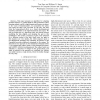Free Online Productivity Tools
i2Speak
i2Symbol
i2OCR
iTex2Img
iWeb2Print
iWeb2Shot
i2Type
iPdf2Split
iPdf2Merge
i2Bopomofo
i2Arabic
i2Style
i2Image
i2PDF
iLatex2Rtf
Sci2ools
IROS
2007
IEEE
2007
IEEE
Bipedal walking on rough terrain using manifold control
— This paper presents an algorithm for adapting periodic behavior to gradual shifts in task parameters. Since learning optimal control in high dimensional domains is subject to the ’curse of dimensionality’, we parametrize the policy only along the limit cycle traversed by the gait, and thus focus the computational effort on a closed one-dimensional manifold, embedded in the high-dimensional state space. We take an initial gait as a departure point, and iterate between modifying the task slightly, and adapting the gait to this modification. This creates a sequence of gaits, each optimized for a different variant of the task. Since every two gaits in this sequence are very similar, the whole sequence spans a two-dimensional manifold, and combining all policies in this 2-manifold provides additional robustness to the system. We demonstrate our approach on two simulations of bipedal robots — the compass gait walker, which is a four-dimensional system, and RABBIT, which is ten-dim...
| Added | 03 Jun 2010 |
| Updated | 03 Jun 2010 |
| Type | Conference |
| Year | 2007 |
| Where | IROS |
| Authors | Tom Erez, William D. Smart |
Comments (0)

